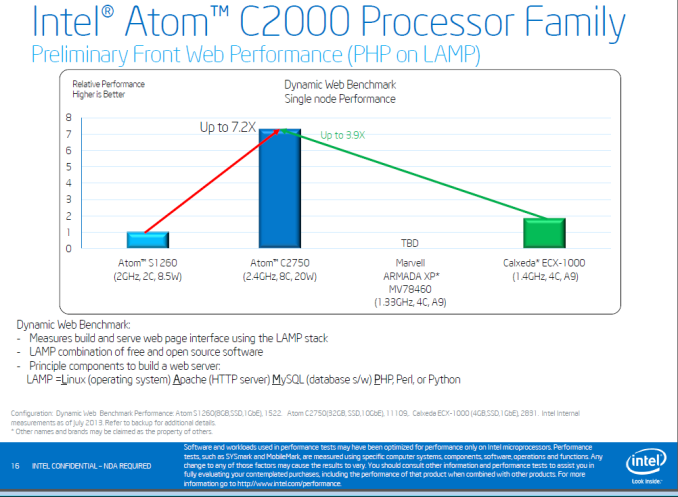The Next Generation of Micro Server SoCs: ECX-2000 vs Atom 2000
by Johan De Gelas on October 29, 2013 5:59 AM EST- Posted in
- Enterprise
- Intel
- Arm
- Calxeda
- Avoton
The benchmarking team of Intel Portland did their best to produce some really interesting benchmarks at the last server workshop in San Francisco, but many of the benchmarks did not work well on the ECX-1000 due to the very limited 4 GB RAM capacity. The most interesting benchmark can be found below: a front end web performance benchmark with high network traffic.
In this benchmark, Intel finally admits that the S1260 is nothing to be excited about. The Intel findings are very similar to ours: the ECX-1000 beats the the Atom S1260 by a wide margin in typical server workloads. So where will the ECX-2000 end up? We can not be sure, but we can roughly estimate that it will land somewhere between being 3 to 4 times faster than the Atom S1260. That is not enough to beat the Atom C2750, but that is after all a 20W TDP chip and the top SKU. Digging deeper in the Intel docs, we find that the C2730 at 1.7 GHz (12 W TDP) consumes about 20W for the whole server node (16 GB and 250 GB HD) and the C2750 about 28W when running SPECint_rate_2006. The harddisk will have consumed very little, since the SPECint_rate_2006 benchmark runs out of memory.
The ECX-2000 at 1.8 GHz will probably need roughly 12-16W per server node. So our first rough estimates tell us that the C2730 is out of the (performance) reach of the ECX-2000, and that Calxeda's estimate of the C2530 is right on the mark.
However, the story does not end there. The total power consumption of the ECX-1000 based Boston Viridis server we tested was remarkably low, the very efficient network fabric made sure there was little "power overhead" (PHYs, Backplane,...). This Fleet Fabric has been improved even further, so there is a good chance that the ECX-2000 based servers will offer a very competitive performance/watt, although the Atom C2730 has an edge when the application benefits from more threads. But when that is not the case, i.e. scaling is mediocre beyond 4 threads, the tables might turn. Anyway, there is a very good chance that the ECX-2000 is very competitive with the 4-core Atoms, to say the least.

There is indeed a reason why HP will use the Calxeda SoC in its new Moonshot server cluster in 2014. The picture above shows such a moonshot module. We felt that the Atom S1260 SoC was a bad match for the HP moonshot, but "HP's Moonshot 2.0" will be an entirely different story. And for those of us with less cash to burn we are looking forward what Penguin computing and Boston will make off their ECX-2000 based server.
Next stop, the 64-bit SoC code-named “Sarita,” based upon the 50% faster Cortex-A57 core, which is pin-compatible with the ECX-1000 and new ECX-2000. This reduces development time and expense for the ODMs. But right now, we can look forward to some interesting microserver comparisons in Q1 2014...











45 Comments
View All Comments
texadactyl - Friday, November 1, 2013 - link
Just be sure to stay clear of the NANO-5050 based on my experience with the Intel D2550MUD2. They're both running GMA3650 graphics ("Cedar Trail", originally developed by PowerVR). There is very limited support in Linux and Windows. In fact, Intel only provides Windows driver downloads for *32*-bit Windows (nothing for Linux). Personally, I'll be very careful before buying another Intel based or provided motherboard.stagn - Tuesday, October 29, 2013 - link
Yes, where can I buy micro-boards (smaller than mini-ITX) with these. At least 2 gigabit Ethernet and 2 cores. I don't need a Bay Trail chip since I won't be connecting it to a monitor.ShieTar - Tuesday, October 29, 2013 - link
Nope. Out of curiosity, what is you design logic for wanting less than mini-itx, but gual GigE ports? I can think of a few applications, but basically all of them seem to be served as well by a router with an open source firmware.pjkenned - Tuesday, October 29, 2013 - link
Hi Johan,If you want me to run tests on the C2750 let me know. Published these a while back: http://www.servethehome.com/Server-detail/intel-at...
In some synthetic benchmarks the 8-core C2750 is more than 10x faster than the S1260. My general characterization is that it feels more like half of a Intel Xeon E3-1220 V3 in terms of performance. Power consumption for a mITX C2750 platform including 32GB (4x8GB @ 1.35v) cooling and a SSD is 33w with everything including the 4x Intel i354 Gigabit Ethernet ports running.
About the same both on the Supermicro and ASRock units we have tested thus far. Happy to run some benches if you want. Should be getting the fourth platform in the next two weeks so can spare.
Other cool news is that the C2750 runs ESXi fine. If Intel included VT-d it would be a category killer with passthrough. I think you are right that the C2550 or C2730 may be better NAS chips because even on the 12 disk ASRock C2750D4I you can run RAID-Z2 and have plenty of CPU power left over.
JohanAnandtech - Wednesday, October 30, 2013 - link
Interesting comparison. However, I have a few nits to pick. "There is a major myth that the Intel Atom C2750 is many times slower in single threaded performance", but most of your "closer to realworld" benches tell exactly the opposite :-). See the crafty bench for example.milli - Wednesday, October 30, 2013 - link
Johan that's not really a fair thing to say. The Xeon E3 and Opteron turbo to 3.7 and 3.6Ghz respectively. The Atom will turbo to 2.6Ghz. Compared to the Xeon L5520 (2.26Ghz), it's only around 20% behind. That's quite a feat for a cpu core that uses around 2W.With the clocks normalized, it's almost 5x faster than the S1260 it replaces, only 35% behind the Opteron and 2x slower than the E3.
He concludes the following: "performance generally around half of the Intel Xeon E3-1200 V3 series". Seems right to me.
JohanAnandtech - Wednesday, October 30, 2013 - link
1. The clockspeed is part of the µarchitecture trade-offs. So you can not simply normalize clocks.2. The point I was making was about "single threaded performance". It is not even close to being half that of a Xeon... more like one fourth. Not bad, but it is *not* a myth that Atoms are "several times" slower single threaded.
Not saying the Atom C2000 is a dog (it is pretty amazing in fact), just pointing out that the C2000 is still "several times" slower per thread. The myth has not been debunked yet...
pjkenned - Thursday, October 31, 2013 - link
Even there 1/3 of the E3 V3 performance at < 1/4 the platform power consumption on a single threaded application. The difference is that the C2750 is not 1/10th or less the speed like the S1260 was.geekfoo - Friday, November 1, 2013 - link
Patrick, how come you dont run x264 and ffmpeg tests given these are quite popular things to do on servers both home and industrial ?something along the lines of
FOR %%A in ("*.mkv") DO (
ffmpeg.exe -threads 0 -i "%%A" -f mp4 -vcodec libx264 -crf 16 -minrate 900k -maxrate 2100k -bufsize 2100k -refs 3 -preset slow -vprofile high -strict -2 -acodec aac -ac 2 -ab 192k -vf yadif,hqdn3d,unsharp=5:5:0.5,gradfun "%%~nA.MP4"
)
for .bat and easy to edit slightly for bash
for f in *.mkv
do
name=`echo "$f" | sed -e "s/.mp4$//g"`
./ffmpeg -threads 0 -i "$f" -f mp4 -vcodec libx264 -crf 16 -minrate 800k -maxrate 1800k -bufsize 1800k -refs 3 -preset slow -vprofile high -strict -2 -acodec aac -ac 2 -ab 192k -vf yadif,gradfun,hqdn3d,unsharp=5:5:0.5 "$name.MP4"
done
pjkenned - Sunday, November 3, 2013 - link
@geekfoo - will look into adding the bash one. The new development version of the script adds a redis benchmark and sysbench CPU tests. It also now works on CentOS as well as Ubuntu from a clean install:http://forums.servethehome.com/processors-motherbo...
Feel free to give it a try to compare. Will add the above as an open item once I get back to the US this week.